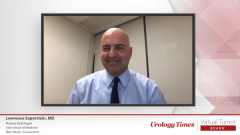
Discussing Treatments with Patients Based on Prostate Cancer Imaging
A radiation oncologist explains how to discuss the interpretation of prostate cancer imaging with patients in deciding on a treatment plan.
Episodes in this series

Neal Shore, MD, FACS: Mike, let's throw it back to you, and then would love to hear Steven's thoughts as well on this case. How did you conclude in your tumor board reflection on interpreting this imaging, and what did it do for your treatment decision-making? And how did you dialogue with the patient and his family?
Michael Gorin, MD: Based on this imaging, the patient's end stage is now N1. They have no sites of distance disease, they’re clinical M0. On this basis, I recall the patient was leaning towards radical prostatectomy. I steered this patient towards radiation therapy with concomitant deprivation with consideration for abiraterone as well. And this is critical because we know the patient has disease that has already escaped the prostate. We know that the sensitivity of the imaging modality is not perfect. We could assume to some extent that he's at risk for having disease outside the radiation field, which would include the pelvic lymph nodes, and that this patient could benefit from not only radiation but also systemic therapy. In contrast, if I was just to do surgery, I would only be removing the lymph nodes; perhaps that 1 involved lymph node and the prostate, but the patient would suffer a significant quality-of-life adverse effect from it, including several months of stress urinary incontinence, and potentially end up requiring systemic therapy anyway because we undertreated his disease. When I spoke to this patient and the family about his options, I stressed my concern that there could be additional disease outside the pelvis here. And that's why I would lean against surgery.
Neal Shore, MD, FACS: Steven, here you go. You've got a urologic surgeon telling you he's moving to radiation, and based upon these findings, do you agree with that? And if yes, why? And then would you do anything otherwise differently and, have a different discussion with the patient and family?
Steven Finkelstein, MD, DABR, FACRO: First, I would say, as a radiation oncologist, how could I disagree with Mike, who just said he wanted to do radiation oncology? That's the first thing. But all kidding aside, I would say when we see these patients in the clinic currently, and even for the last several years to decade, we would say as radiation oncologists that for high-riskprostate cancer that radiation therapy and surgery are felt to be equivalent. Without having fancy imaging to tell us what to do, we would say that, as radiation oncologists, if you have surgery, if you have radiation, they're both reasonable options. But if you could do an imaging modality such as we see here and can show there's disease outside of the prostate and it was in a place where you could cover that spot as you cover the lymph nodes up to the aortic bifurcation, you have a chance of curing that guy. I would say that that has helped patients to get the right treatment for the right problem. Now, additionally, it didn't show disease outside of the pelvis, right? It did not show distant metastatic disease. And again, you're saying that maybe there's a modality that we could do that's going to be a local modality. Now it's going to cover the prostate primary side, it's going to cover the lymph nodes, but still, it's a local modality. And what I like—being a surgeon who became a radiation oncologist—is the ability to use the anatomy to know what to go after and what not to go after; it is probably the most important thing we can do. Now, what would've happened in this case if you saw what we see in here, plus another spot in a bone? And that's where the conversation gets even more interesting, right? These are patients who we've classically treated with radiation therapy and deprivation for many, many years. And a large chunk of those patients—most of those patients—do well for a really long time. There are interesting caveats that come into play with those scenarios. But with this specific scenario, you have a guy with disease in the prostate, diseases in the regional nodes. You can cover both of those things with radiation therapy, with systemic therapy that is androgen deprivation therapy, and hopefully, give this patient a potential cure.
Neal Shore, MD, FACS: Let me just add to that hypothetical. Same case that Michael has presented, but now in addition to the pelvic nodes the patient has, let's say, 1 high-up retroperitoneal node in the perineal area, or an isolated small rib lesion, or an isolated axial spine lesion. How would you approach that, Steven?
Steven Finkelstein, MD, DABR, FACRO: That's a great question. I find myself probably as a more aggressive treater of disease...as a surgeon who became a radiation oncologist. I think there's a potential to treat a metastatic disease and some patients, if you look at the classic data from Rosenberg et al in PPO, 20% of those patients across disease sites who were treated with surgical interventions from metastatic disease did well. It's hard to know who those people are. Classically what we would've done with someone who we thought had metastatic disease is we would've given them androgen deprivation therapy. We would not have gone to heroic claims to treat either the primary or other sites unless it was palliative treatment, something was hurting, and you were fixing a symptom. But today with low volume disease, it begs us to reevaluate the things that we've done and say, does it make sense in a guy with disease isolated to the prostate, like we saw disease isolated to the regional a couple of pelvic lymph nodes, to treat an encompassing pelvic field while they get their primary treated? And then if there was a small spot in the rib, treat that specific spot. Give them the benefit of the doubt. Now, again, there needs to be larger clinical trial data to look and see how those patients do. And I don't think we've done as well a job as we could do to capture that data today. But the ability to do this fancy next-generation imaging gives us the opportunity to create those trials, to be able to capture that data, to see what the true benefit is for pulling the trigger on radiation therapy in the oligometastatic setting.
Neal Shore, MD, FACS: Great points. And there's so many great ongoing studies and more planned to look at metastasis-directed therapy.
Transcript edited for clarity.
Newsletter
Stay current with the latest urology news and practice-changing insights — sign up now for the essential updates every urologist needs.























